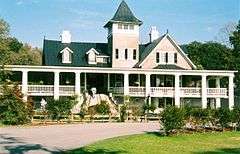Magnolia Plantation and Gardens (Charleston, South Carolina)
|
Magnolia Plantation and Gardens | |
|
Plantation home at Magnolia Plantation | |
  | |
| Nearest city | Charleston, South Carolina |
|---|---|
| Coordinates | 32°52′32″N 80°05′00″W / 32.87556°N 80.08333°WCoordinates: 32°52′32″N 80°05′00″W / 32.87556°N 80.08333°W |
| Area | 390 acres (160 ha) |
| Built | 1850 |
| NRHP Reference # | 72001198[1] |
| Added to NRHP | December 11, 1972 |
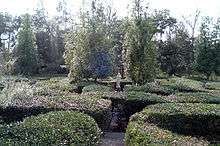

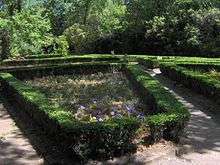
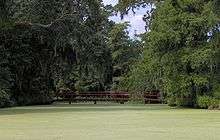
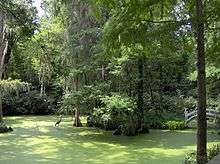
Magnolia Plantation and Gardens (464 acres, 187.77 hectares) is a historic house with gardens located on the Ashley River at 3550 Ashley River Road, Charleston County, South Carolina.[2][3] It is one of the oldest plantations in the South, and listed on the National Register of Historic Places. Magnolia Plantation is located near Charleston and directly across the Ashley River from North Charleston. The house and gardens are open daily; an admission fee is charged.
The plantation dates to 1676, when Thomas and Ann Drayton built a house and small formal garden on the site. (The plantation remains under the control of the Drayton family after 15 generations.) The historic Drayton Hall was built in 1738 by John Drayton, father of judge John Drayton, Jr., on an adjoining property. Magnolia was originally a rice plantation, with extensive earthworks of dams and dikes built in fields along the river for irrigating land for rice cultivation. African slaves from rice-growing regions created the works. As time went on, the slaves developed a creolized Gullah language and culture, retaining many elements from Africa.
History
Magnolia became known for its gardens after the Reverend John Grimke-Drayton inherited the property in the 1840s and developed them. Through his mother, Grimke was the grandson of Thomas Drayton, who bequeathed the plantation to him on condition that he take the Drayton surname. Through his father, John was a nephew of Sarah Grimke and Angelina Emily Grimke.{{
Grimke-Drayton, an Episcopal minister, began to have the gardens reworked in an English style; according to legend, this was done to lure his bride south from her native Philadelphia. He was among the first to use Camellia japonica in an outdoor setting (1820s), and is said to have introduced the first azaleas to America. Under his supervision, the gardens of Magnolia on the Ashley became well known in the antebellum period for their azaleas and live oak trees. They were photographed by Mathew Brady, who would later become famous for his photographs of the American Civil War. Another visitor to Magnolia in this period was John James Audubon, for whom Magnolia's Audubon Swamp Garden is named.
The plantation house was burned during the Civil War, likely by Union troops. In the aftermath of the Civil War and postwar economic disruption, John Drayton opened the gardens to the public to earn money as a tourist attraction.
In the twentieth century, notable visitors have included George Gershwin, Henry Ford, Eleanor Roosevelt, Orson Welles and Reba McEntire. In the early 20th century, the impressionist painter William Posey Silva painted the garden a number of times, and several of his canvases are on display in the main house.[4]
Description
Magnolia Plantation is operated as a house museum and tourist attraction. It has a reconstructed and restored plantation house, based on what was built after the Civil War. The oldest section was built prior to the Revolutionary War near Summerville. It was transported down the Ashley River after the Civil War and added to the house during its rebuilding. The wide verandah and huge columns were added more recently.
Of the five cabins on site, four were built in slavery times and one about 1900. They have been restored to differing periods: 1850 and other decades after the war, into the twentieth century, as they housed free as well as enslaved workers. The interpretive program reflects African-American history at the plantation, From Slavery to Freedom. Archeological work is revealing more about the lives of both slaves and free black workers, who were skilled gardeners and craftsmen.
Other elements of the plantation emphasize the natural setting: a nature train, a marsh boat tour, and a wildlife area. A petting zoo and the gardens feature a kind of cultivated nature. Many of today's attractions were built starting in 1975 during the garden's renewal.
Major garden features include numerous azalea plantings, as well as:
- Barbados Tropical Garden - indoor tropical garden.
- Biblical Garden - plants mentioned in the Bible, with Old Testament and New Testament areas
- Camellia Collection - First Camellia japonica plantings date from the 1820s, with current plantings containing nearly 900 varieties. Nearly 150 were bred in the gardens' nursery.
- Cattail Wildlife Refuge - approximately 500 acres (2 km²), with tower for bird observation.
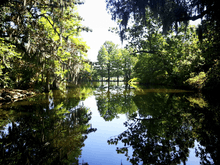
- Cypress Lake - Bald cypress trees, up to 100 years old, along riverbanks and wetlands.
- Flowerdale (50 acres) - Oldest sections established 1680. Formal plantings of annuals set within triangular beds enclosed by boxwood hedges. Two large camellias date from the 1840s.
- Long Bridge - Built in the 1840s, one of seven bridges on the grounds.
- Maze - replica of England's famous Hampton Court maze, but planted with some 500 Camellia sasanqua interspersed with Burford holly. Nearly 14 miles (23 km) of pathways.
- Nature Center and Zoo - domesticated animals typical to Southern plantations, injured or orphaned native animals, and exotic birds including Malayan jungle fowl, guinea hens, and peacocks.
- Swamp Garden - emphasizing indigenous plants and rich ecosystem.
See also
References
- ↑ National Park Service (2010-07-09). "National Register Information System". National Register of Historic Places. National Park Service.
- ↑ Bull, Elias B.; Bernard Kearse. "Magnolia Plantation and Gardens" (pdf). National Register of Historic Places - Nomination and Inventory. Retrieved 10 June 2012.
- ↑ "Magnolia Plantation and Gardens, Charleston County (S.C. Hwy. 61, Charleston vicinity)". National Register Properties in South Carolina. South Carolina Department of Archives and History. Retrieved 10 June 2012.
- ↑ "Garden of Dreams". Magnolia Plantation & Gardens website. Accessed June 10, 2016.
External links
| Wikimedia Commons has media related to Magnolia Plantation, South Carolina. |
- Magnolia Plantation and Gardens, Official website
- Magnolia Plantation Visitor's Info, Charleston Insider's Guide
